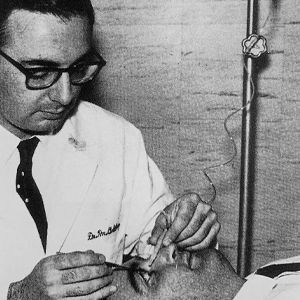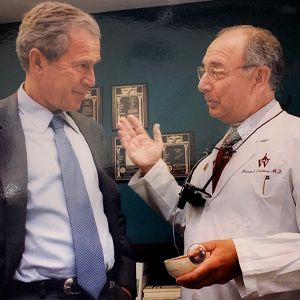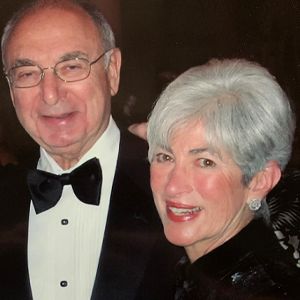The professional life of Morton F. Goldberg, MD, spans myriad leadership positions as well accolades over more than few decades.
As the director and William Holland Wilmer professor of the Wilmer Ophthalmological Institute of the Johns Hopkins University School of Medicine from 1989-2003, he also found time for these other positions: president of the Macula Society, president of the Association for Research in Vision and Ophthalmology (ARVO), president of the Association of University Professors of Ophthalmology (AUPO) and editor of Archives of Ophthalmology (now referred to as JAMA Ophthalmology).
Dr. Goldberg’s seminal contributions to ophthalmology and numerous awards and honors include: membership in the Institute of Medicine (National Academy of Medicine), the Howe Medal of the American Ophthalmological Society, the Ida Mann Medal of Oxford University, the Isaac Michaelson Medal of the Israel Academy of Natural Sciences and Humanities, the Weisenfeld Prize of ARVO and the Arnall Patz Medal of the Macula Society.
Dr. Goldberg has contributed over 600 papers to ophthalmological literature and published 10 books on subjects from eye trauma to genetic and metabolic eye disease. All of this information is readily available from his curriculum vitae, which can be accessed through the internet. Scope’s focus on Dr. Goldberg will explore the people, events and decisions that shaped the career of this remarkable individual.
Childhood
Morton (“Mort”) Falk Goldberg was born in Lawrence, Mass. in 1937. The only child of Helen Janet Falk (also born in Lawrence although her family had immigrated from Vilna, Lithuania) and Maurice Goldberg (who also immigrated from Lithuania in a region currently part of Belarus), Dr. Goldberg’s family moved to Amesbury, Mass., when Mort was 3 years old.
Amesbury is a small town near the New Hampshire-Massachusetts border near the coast. During the summer in high school and college, Mort served as an ocean beach lifeguard. The 15-mile-long beach presented big, rolling waves, a strong undertow, and 60-degree Fahrenheit water temperature. Each summer morning, Mort completed a one-mile swim, and on several occasions, he saved swimmers from drowning. From these experiences, Mort’s interest in scuba diving, marine biology, and water life had their origins.
Although Mort considered becoming a marine biologist, exposure to his father’s general medical practice fostered an interest in medicine. Maurice Goldberg’s office was based in his home. Mort made house calls with his father ($3/house call visit). Through this experience, Mort was exposed to the full spectrum of society.
Many patients were poor and could not afford the $2 charge for office visits, which led to bartering. Patients offered what they could in exchange for medical care; e.g., four lobsters/visit. Physicians were the most respected persons in the town. Apart from brief contemplation of marine biology, Mort never seriously considered anything other than a career in medicine.

Dr. Goldberg as second year resident, Wilmer Eye Institute, 1964.
Education
Mort was a precocious student (e.g., transitioned directly from kindergarten to second grade), and he was the valedictorian of his public high school class. Mort’s love of English led inevitably to his love of writing. He served as the editor of the senior class yearbook. As a high school student, he was a reporter for the Amesbury Daily News and wrote a weekly byline column: “Report from Mort.” The column featured interviews with various leaders at the high school, such as the football coach. Mort explained that he was paid 25 cents/inch, so he quoted the interviewees at length!
In high school, Mort was fortunate to have outstanding teachers in Latin (Otto Wagner), English (Roland Woodwell) and biology (Frank Kozacka), all of whom were graduates of Harvard and who wrote letters in support of his college application. Although accepted at Yale, Cornell, Dartmouth, and Brandeis, Mort received a scholarship at Harvard, which was a source of great pleasure as well as pride for his parents. Mort’s respect for his Latin, English, and Biology teachers, though, guided his choice. Mentorship at this moment and at many other critical points in his life played a major role in the career-defining choices Mort made.
At Harvard College, Mort was a biology major, magna cum laude, PBK, and once again was inspired by his teachers, some of whom were Nobel laureates, e.g., James Watson and George Wald, and all of whom were open to speaking with undergraduates and committed to their education. After his sophomore year at Harvard, Mort spent the summer at Woods Hole, Mass., where he indulged his fascination with marine invertebrates. This knowledge later led to some apt descriptions of ophthalmic clinical findings, including the “brittlestar” description of the posterior tunica vasculosa lentis present in patients with persistent fetal vasculature and the “sea fan” description of retinal neovascularization in sickle cell retinopathy. After his third year, he spent the summer at the Jackson Laboratory in Bar Harbor, Maine, where he learned about genetics.
Mort loved all the courses at Harvard Medical School graduating cum laude, except for psychiatry, which is somewhat surprising in view of the scope of responsibilities he would have as a department chair. Nonetheless, the subject which held his attention most deeply was pathology, possibly because of the influence of yet another mentor, Professor Arthur Hertig, a noted gynecological pathologist who studied blood vessels in uterine development and blood vessel physiology. When Mort sought to complete an elective with Hertig, Hertig advised him to study with David Cogan instead, explaining that Dr. Cogan was a better pathologist! As it happens, Dr. Cogan was developing the trypsin digest technique with Dr. Toichiro Kuwabara at that time. This pioneering work immediately engaged Mort’s interest, afforded him an opportunity to work closely with Dr. Cogan, and, most importantly, enabled him to know Cogan well. Dr. Cogan was brilliant, humble, honest, and charming. It is because of Dr. Cogan’s mentorship and example that after graduation, Dr. Goldberg chose to pursue a career in ophthalmology.
Ophthalmology
The story of how Dr. Goldberg came to be a Wilmer resident will not surprise and may amuse those who are familiar with the past and current resident selection process. After explaining to Dr. Cogan that he wanted to be a resident at the Massachusetts Eye and Ear Infirmary, Dr. Cogan advised Dr. Goldberg to go to the Wilmer Ophthalmological Institute instead.
During this conversation, Dr. Cogan called Dr. A. Edward Maumenee, the chair of Wilmer at the time, whom Dr. Cogan knew well. He suggested that Dr. Maumenee accept Dr. Goldberg as a resident. Dr. Maumenee agreed “on the spot” with the proviso that Dr. Cogan accept a Hopkins medical student whom Maumenee was not going to take as a resident at Wilmer. At that propitious moment, Dr. Goldberg literally had never heard of the Johns Hopkins Hospital, of the Wilmer Ophthalmological Institute, or of Dr. Maumenee. Such was the influence of Dr. Cogan’s mentorship and the trust that Dr. Goldberg placed in this gentle, gifted, and humble man.
While Dr. Goldberg was a Wilmer resident, there were only four full-time faculty members: Dr. Maumenee, Dr. Frank Walsh, Dr. David Knox and Dr. James Duke. Each was inspiring in a different way. Dr. Knox was like a “big brother” to Dr. Goldberg. Dr. Duke fostered Dr. Goldberg’s ongoing interest in eye pathology. Dr. Walsh, arguably the greatest neuro-ophthalmologist in the world, had a teaching style that reflected simultaneously his respect for the residents, his concern for his patients, his great humility, and his awesome fund of knowledge and clinical experience. The quality of the Saturday morning conferences, run by Dr. Walsh, was legendary and had a great impact on Dr. Goldberg. When Dr. Goldberg assumed responsibility as the chair of Wilmer, he never failed to attend resident teaching conferences, and he conducted them masterfully, with evident pleasure. The primary role model in Mort’s life at that point and for many years thereafter, though, was Dr. Maumenee.
Dr. Maumenee was an excellent and innovative surgeon, had an encyclopedic fund of knowledge, set high standards for everyone including himself, was charismatic, and was an excellent fund raiser, an activity that at the time was not held in high regard by many faculty members at Hopkins. In short, Dr. Maumenee was the exemplar of a department chair, and he had a profound influence on Dr. Goldberg’s values concerning scholarship, clinical excellence, and leadership.
As a resident, Dr. Goldberg was academically precocious. He described, for example, fundus anomalies in the Waardenburg syndrome and corneal findings in mucopolysaccharidoses such as the Hunter syndrome. In fact, Dr. Goldberg’s pioneering work describing sickle cell retinopathy was done when he was a second-year resident (Figure 3)! Dr. Goldberg explained that a number of scleral buckle procedures for retinal detachment in patients with sickle cell disease had resulted in phthisis (due to anterior segment ischemia).
During a trip to the Bahamas in which he was scuba diving at 70 feet, he saw enormous sessile colonial soft coral, Gorgonia flabellum, also known in the vernacular as “sea fan” (Figure 4). After returning from the trip, he examined fundus photos of retinal neovascularization in patients with sickle cell retinopathy and recognized the morphological similarity. As patients with hemoglobin sickle cell (HbSC) disease and vitreous hemorrhage were admitted to the Osler medical ward, Dr. Goldberg then began to seek out and do fundus drawings of these patients at night. He identified retinal neovascularization on fundus exam and later examined the patients with Dr. Robert Welch, one of two principal retinal surgeons at Wilmer (the other being Leslie Harrell Pierce).
Dr. Goldberg mentioned to Dr. Welch the morphological similarity of the retinal new vessels in patients with HbSC disease and sea fans. Dr. Welch agreed immediately and then brought to work a preserved Gorgonia specimen of his own to show Dr. Goldberg! It is remarkable that the characterization of sickle cell retinopathy pathogenesis developed by Dr. Goldberg more than 50 years ago continues to be regarded as accurate. This classification was the first to use fluorescein angiography as a basis for defining the different stages of a retinal disease.
Dr. Goldberg chose to pursue fellowship training under the tutelage of Victor McKusick, MD, a professor at Hopkins and the father of medical genetics. When asked why he did not pursue additional surgical training, Dr. Goldberg explained that his surgical anterior segment and retina training as a resident and Wilmer Chief Resident were robust. These experiences and Dr. Goldberg’s growing familiarity with Dr. McKusick’s textbooks on medical genetics led Mort to believe that ophthalmic genetics was “the future.” Recent treatments of blinding retinal disease (e.g., Leber Congenital Amaurosis) with gene therapy have validated that perception.

Morton F. Goldberg, MD, with President George W. Bush at the Wilmer Eye Institute, approximately 2 weeks before Sept. 11, 2001.
Chairmanship
At the completion of fellowship training, Dr. Goldberg was offered a lucrative private practice job in Miami, where he wanted to live. His love of writing, however, rendered complex what otherwise could have been a simple choice. Dr. Maumenee offered him a position on the faculty at Wilmer (for substantially less money) and even identified what is now known as the Wilmer Portrait Room as Dr. Goldberg’s office.
While contemplating these options during the remainder of his fellowship, Dr. Goldberg also was offered several chair positions, the most attractive of which was at the University of Illinois in Chicago. Discussing with Dr. Maumenee the decision to turn down the job at Wilmer, Dr. Maumenee said to Dr. Goldberg, “Don’t you want to tell other people what to do?” So, at the age of 32, Dr. Goldberg became professor and chairman of the Department of Ophthalmology at the University of Illinois College of Medicine in Chicago, then the youngest chairman of ophthalmology in the United States and, possibly, the world.
Dr. Goldberg spent what he regards as 19 of the most productive years of his life at the University of Illinois. He recruited fulltime staff, established a nationally ranked research program, raised the funds to build a research building, established a chief resident position in a program that trained 32 ophthalmology residents annually, and established teaching rounds (including grand rounds, bedside rounds, and teaching conferences). Dr. Goldberg recruited highly influential faculty members to his program (e.g., Professor Gholam Peyman and Professor Mark Tso) and trained some of the most important ophthalmologists of my generation (e.g., Professor Lee Jampol). Dr. Goldberg explained that when confronted with a problem, he would ask himself, “What would Dr. Maumenee do?”
Dr. Goldberg’s accomplishments as chair of the Wilmer Ophthalmological Institute were even more extraordinary. Dr. Goldberg served as an outstanding role model for the residents. He treated us (and our patients) with courtesy and respect, and this demeanor helped us to respect ourselves and to aspire to excellence as physicians.
Dr. Goldberg was a remarkable listener who made me, as a chief resident, feel that he really cared about us as people and about the world in which we, as residents, lived. He had a great sense of humor and generosity, which enabled us to really enjoy professor’s rounds, which he conducted with disciplined regularity. I suspect that he even let us win bets on clinical unknowns so that he could enjoy the pleasure of our company outside of work at local restaurants. Dr. Goldberg also gave wise counsel and never put his own interests ahead of those of us who sought his guidance. He was like a wonderful father, never allowing his larger concerns to intrude into our lives. It seemed to me that we, the residents, were the center of his universe.
Institutional excellence is not due to any single individual. It is the fruit of the labor of many talented, dedicated individuals, as with an orchestra. At Wilmer, Dr. Goldberg was a remarkable conductor of this ensemble of committed individuals. Wilmer was ranked the No. 1 ophthalmology program in the United States in US News and World Report for 12 of the 14 years he served as chair. Following the example of his mentors, Dr. Goldberg was self-sacrificing and always gave credit to his organization and deflected it from himself. At an AUPO workshop, Dr. Goldberg was asked to identify the number of endowed chairs at Wilmer (13 at the time). It was the largest number at any department in the United States, but one could barely hear his voice as he responded modestly.
Most importantly, Dr. Goldberg was a servant leader. He knew his job was to serve everyone-the residents, the faculty, the staff, the donors, and the patients.
Dr. Goldberg’s stewardship of the Wilmer Institute was extraordinary. He increased the fulltime faculty from 64 to 132, increased the number of endowed chairs from three to 20, increased the number of outpatient visits from 58,000 to 120,000 a year, increased the annual operating budget from $27 million to more than $60 million, and increased the endowment from $21 million to $110 million. Dr. Goldberg recognized the need to expand Wilmer’s research infrastructure and so secured the land and initiated the fund-raising effort that led to the construction of the Clarice and Robert Smith building, a freestanding eye research and surgery center.
In addition, Dr. Goldberg renovated all the major floors and the library of the Wilmer Institute (taking care to keep the portrait room!) and added two new floors to the preexisting Maumenee building. According to Suetonius, Augustus Caesar, once said, “I found Rome built of bricks; I leave her clothed in marble.” Of course, the grandeur of Wilmer, both physical and intellectual, is longstanding, and it is the product of visionary leaders, including Drs. Wilmer, Woods, Maumenee, Patz, and the current chair, Peter McDonnell, as well as the fulltime faculty, residents, and staff. But the “Augustan marble” that Dr. Goldberg left at the close of his tenure, and that truly helped to keep Wilmer great, is not the buildings or the endowment. It is the values that he sought to instill in each of us as residents and in each of the members of the Wilmer Institute.

Dr. Goldberg and his wife, Myrna Goldberg, MSW, pictured in 2000.
Family
Mort met his wife, Myrna Davidov, at a beach party on the Severn River hosted by Dr. Charles Iliff, a prominent oculoplastic surgeon and member of the volunteer Wilmer faculty. Mort was a first-year resident at the time, and Myrna was a social worker at the Johns Hopkins Hospital.
Their union has been blessed with two children, Matthew Falk Goldberg (lawyer, 48) and Michael Falk Goldberg (chief of neuroradiology, Allegheny Medical Center, and associate professor at Drexel University, 45). Matthew and Michael married wisely, and they and their wives have produced four grandsons, a source of great joy in Mort and Myrna’s lives. Myrna is an intelligent, perceptive, and charming woman who not only created a loving home environment for Dr. Goldberg and their children. She also served as a source of wise counsel and support.
“I have never made any decision of consequence without her approval,” Dr. Goldberg said.
Conclusion
Dr. Goldberg, MD, is one of the most influential ophthalmologists of the 20th century by virtue of his intellectual contributions, his leadership in many important ophthalmology organizations, his mentorship of hundreds of residents and fellows who have contributed to patient care through clinical practice as well as through innovative research, and through his visionary leadership of two highly important departments of ophthalmology.